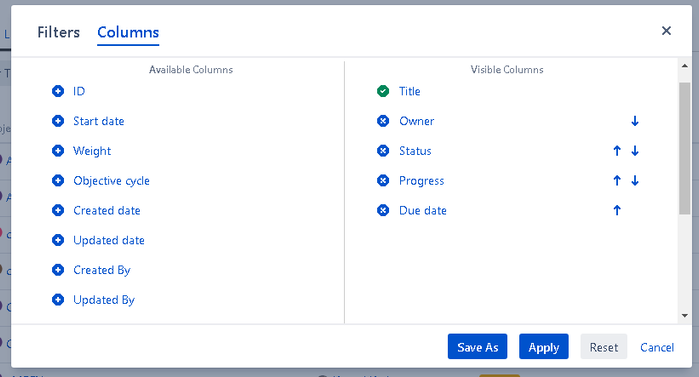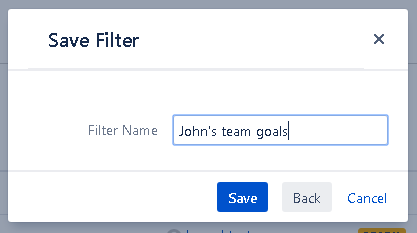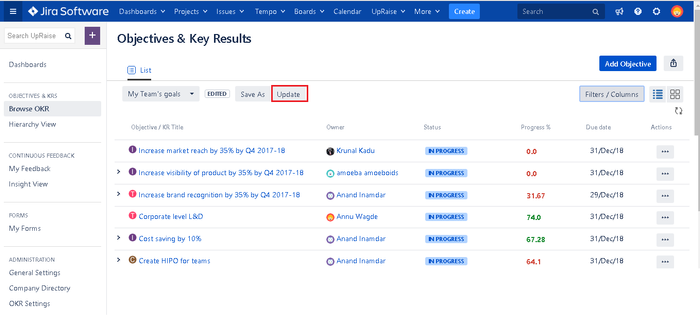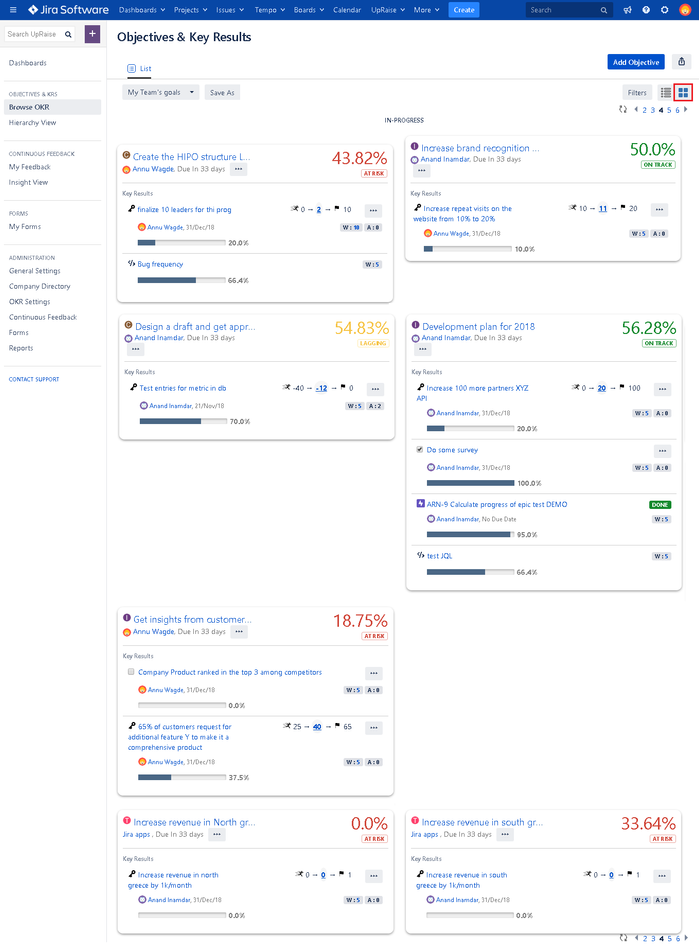Browse OKRs page (v3.9.1)
Click on browse OKRs option under objective & KR menu in the left-hand navigation or from top menu. This page allows you to check the list of your OKRs using different filters and views. This page is useful when you want to get a quick snapshot of your OKRs in different durations, progress percentages, statuses, etc. Many other use cases are listed at the end of this page. This page allows creating desired view of OKRs.
At the top, there is a drop-down menu that shows different OKRs lists of OKRs visible to you.
- All OKR - All OKRs those are visible to you as a logged in user, irrespective of their level (Company, Team or Individual).
- Individual OKR - All individual-level OKRs those are visible to you as a logged in user.
- Team OKR - All team level OKRs that are visible to you as a logged in user.
- Company OKR - All company level OKRs that are visible to you as a logged in user.

List view
These OKRs at different levels can be managed as per your requirements to create a specific view for yourself. Browse OKRs page can be typically used as your own customized dashboard of OKRs for weekly, monthly meetings. We have shared a few more use cases in last section of this page.
To create your own OKR view there are three options -
- Filters
- Columns
- Saved filters
Filters

- Click on filters/columns button at the top right corner of the browse OKR page.
- On the given pop-up, you are on filters tab by default.

- Listed are the filters in filters tab -
- Level - Level of objective/s
- Objective Cycle - Relevant objective cycle status from the drop-down.
- Owner - Select the relevant type of user or you can also select users in bulk by clicking on the search icon that appears after selecting 'select users' option in the drop-down.
- Status - Objective status/es.
- Objective start date - From the drop-down, you can select any objective start date or you can select different rage of dates or durations to get specific results.
- Objective due date - From the drop-down, you can select any objective due date / you can select different rage of dates/durations to get specific results.
- Labels - Select a relevant option from the drop-down and then select appropriate labels to get the objective list classified on the basis of labels.
- Results - Number of results should appear on one page.
- Click on 'show more' to see further filter options -
- Teams - Select team name/s from drop-down for team wise list of objective.
- When you have selected company or individual levels in levels option, system displays the list of objective of owners who belong to selected teams.
- When you select team level in levels option, system displays the list of OKRs of selected teams.
- Team type - Define specific team type/s when you are looking for departmental objectives or specific team type's objectives.
- Objective Progress % - You can select a range of objective progress% of define a specific progress %.
- Last punch-in - Define the specific date or date range to see when was/were objective/s punched in last.
- Created by - Select a specific user or set of users who created objective/s.
- Updated by - Select a specific user or set of users who updated objective/s.
- Created date - Define the specific date or date range to see when was/were objective/s created.
- Updated date - Define the specific date or date range to see when was/were objective/s updated (attribute changes, new KRs added or deleted existing ones, users added to visibility list, etc).
- Owner's teams/s - Filter on the basis of objective owner's teams.
As described in above list, you can make use of any of these filter options to create your own browse OKRs page. Once applied relevant filters click on apply to see results. You can also make use of save as option to save applied filters so that filtered view gets saved and can be navigated anytime. Read Use cases for Browse OKR filters.
Columns
On browse OKR page, system allows you to manage columns of your choice. Click on columns/filters button, select columns tab. On this tab select the list of columns and set the order of selected columns as you want. Click on apply or save as to permanently save the view as your own filter. Read the save filters section for more details.
If you reset these settings before saving the filter, system will switch back to the default browse OKR columns again.

Saved filters
You can create save filters in two ways -
Create saved filters immediately after applying relevant filters
- After applying relevant filters and column options, you can make use of 'save as' option. This allows saving the filter with a name. This will be your own filter & you can switch to it anytime. Eg. - If you have applied filters specific to your team's objectives and saved it as 'My team's objectives'.

Create saved filters from 'save as' option below objctive filter drop-down
- Above option allows saving the filter immediately after applying filters and columns. However, in any case, if you want to review the list and then save, you can use the save as option appears below filter dropdown list only after you apply filters.
- If you want to replicate the same filter as it is or with some changes you can use this save as option.
Update the saved filter
- Select the relevant saved from the drop-down, make changes in filters or column click on apply. Now you will see that update button appears just beside the save as button below list drop-down, click on that & same filter will be saved with new changes.

Rename or delete the saved filter
Select the filter that you want to rename or delete.
- Click on rename, edit the name and click on rename.
- Select the delete option and confirm the action.
Thumbnail view
From thumbnail view, you can follow same steps mentioned above to create own filters or apply them to the default lists. In thumbnail view, there is no column selection option as that is not applicable in thumbnail view. Thumbnail view is displayed with some default objective attributes and you cannot change them.

On this table
In this section
- How to add KR punch-in reminders?
- How does automatic confidence score calculation work?
- What are different OKR confidence statuses(default) in UpRaise?
- Default confidence status calculations
- How to use KR progress automation?
- How to move Key results?
- Use cases for Browse OKR filters
- Create, edit or delete objectives
- How to browse through your OKRs from browse OKRs page?
- Concepts - Objectives, Key Results, Punch-ins, Alignment, Weightage, Grading, Labels
- How do I add & delete objective alignments?
- How do I adjust weightage of a KR?
- How do I create, edit & delete key results?
- How do I grade my OKRs?
- How do I mark progress on objectives or key results?
- How does progress roll up work in alignment?
- How does the progress calculation of Jira issues and epics works?
- How does weightage of a KR impact the objective progress?
- How to add Jira issue KR via JQL?
- How to add Jira issues as actions in metrics and to do KRs?
- How to carry forward an objective?
- How to clone an objective?
- How to convert objective from one level to another?
- How to move an objective?
- How to use objective details page?
- Is alignment possible only for objectives?
- What are different objective statuses?
- What is hierarchy view & how does it work?
- What is KR detail page?
- What is objective cycle?
- What is the impact of objective visibility on alignment?
- What type of KRs are possible in Employee Success?
- What type of objective visibility options are available?
- When to use each type of KR - To do, Metric, Jira issue & Jira issue via JQL?
- Why I can't create / edit company level, team level or individual level objectives?
- Why isn't the punch-in action available on my objective?
Past versions
